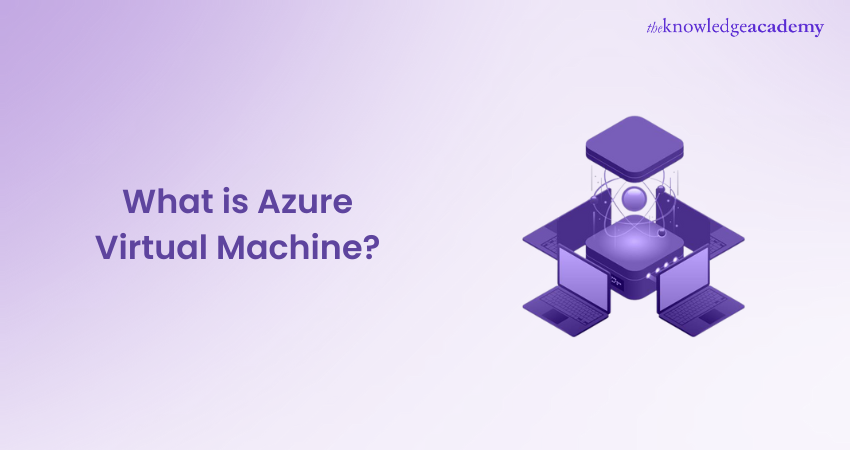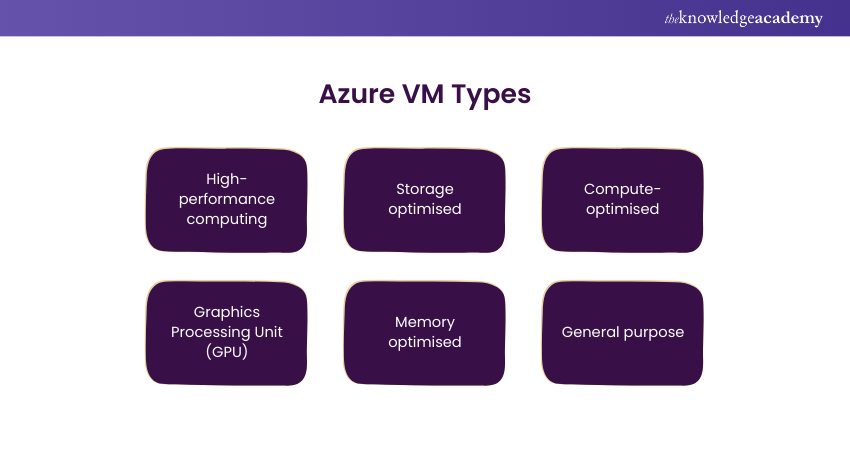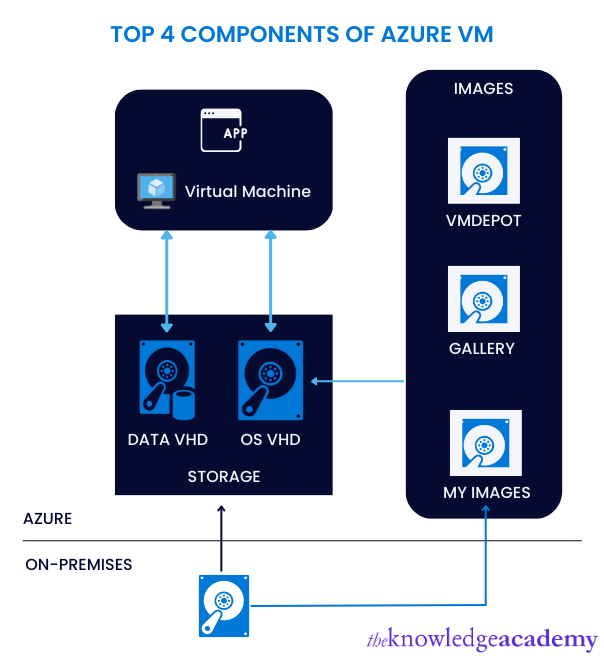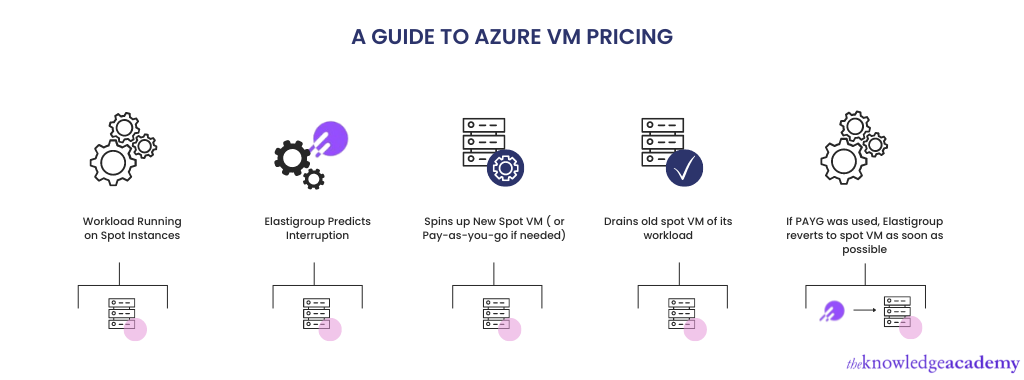We may not have the course you’re looking for. If you enquire or give us a call on 01344203999 and speak to our training experts, we may still be able to help with your training requirements.
Training Outcomes Within Your Budget!
We ensure quality, budget-alignment, and timely delivery by our expert instructors.
- Designing and Implementing Enterprise-Scale Analytics Solutions Using Microsoft Azure and Microsoft Power BI DP500
- Microsoft Azure Administrator AZ104
- Data Engineering On Microsoft Azure DP-203 Certification
- Microsoft Azure Security Technologies AZ500
- Designing And Implementing Microsoft DevOps Solutions AZ400

Lets dive into “What is Azure Virtual Machine?” Azure Virtual Machine is a service that allows you to create and manage Virtual Machines in the cloud. This Virtual Machine is based on the concept of virtualisation, which enables you to use the same physical resources more efficiently and flexibly. It also offers various benefits, such as scalability, security, reliability, and cost-effectiveness.
In this blog, we will explore what an Azure Virtual Machine is in more detail. We will also look its uses and features that can help you achieve your goals.
Table of Contents
1) What is Azure Virtual Machine?
2) Azure Virtual Machine size
3) Why Azure Virtual Machine?
4) Components of Azure VM
5) Azure VM use cases
6) Azure Virtual Machine pricing
7) Conclusion
What is Azure Virtual Machine?
Azure VMs are on-demand computing resources under the name Azure Virtual Machines. while Azure Pipelines facilitate automated deployment and management processes, ensuring efficient utilisation and optimisation of Virtual Machines within Azure environments. The Azure VM platform allows users to work flexibly without buying physical hardware. Azure Virtual Machines comes under the Azure’s Infrastructure as a Service (IaaS) section. It has many applications, including:
a) Extended Datacentre
b) Development and test
c) Cloud applications
A key component of hardware virtualisation is Azure Virtual Machines. They are pre-built computers that were created using the virtualisation idea, Leveraging this concept, Microsoft Azure offers a range of pre-configured computing resources for streamlined deployment and scalability. The Azure VM's underlying idea is the same as that of the cloud platform's virtualisation.
Azure VM is a computing service that enables users to host their Windows and Linux-based systems or applications in the cloud. Azure VMs offer users flexible virtualisation without requiring any initial investment of funds or ongoing maintenance of the underlying physical infrastructure.
Types of Azure VMs

The most frequently used types of Virtual Machines are:
1) High-performance computing: These Azure VMs have the fastest and most powerful CPUs and high-throughput (amount of material passed through the system) network interfaces.
2) Storage optimised: High disc throughput and IO(Input/Output) make these Virtual Machines (VMs) perfect for data warehousing, NoSQL databases, SQL, Big Data, and large transactional databases.
3) Compute-optimised: These Azure Virtual Machines have a high CPU-to-memory ratio. It is the best choice for network hardware, application servers, and web servers with medium traffic.
4) Graphics Processing Unit (GPU): Azure VMs with GPU capabilities are designed to edit and render complex graphics. They can also be implemented for deep learning-based training and differentiation. The user has the option of using one or more GPUs.
5) Memory optimised: It works well for memory analytics, medium-sized to large caches, and relational database servers. The memory-optimised Azure VMs have a high memory-to-CPU ratio.
6) General purpose: It features a balanced CPU-to-RAM ratio that makes it excellent for testing and deploying small- to medium-sized databases.

Workloads of Azure VMs
There are two ways you can go about moving to an Azure VM. In this tutorial on creating Azure Virtual Machines, you will learn these two important ways to transition to an Azure VM.
a) Suitable workloads
1) The workloads that can be hosted on a cloud architecture provided by Azure
2) Service Workloads like those of online shops for business
3) Unpredictable workload increases from things like short-term sales growth and organisation development
4) Retail sales over the festival season
b) Unsuitable workloads
1) IaaS (Infrastructure as a Service) applications or services that aren't suited for Azure VM Workloads
2) A small business with limited growth that can operate the service for less money than the cloud
3) Workloads in regulated environments that are prohibited by the laws from moving to the cloud
Master the art of migrating NoSQL workloads to Azure Cosmos DB. Sign up for the Migrate NoSQL Workloads To Azure Cosmos DB DP060 Course today!
Azure Virtual Machine size
In the Azure Portal, users can create VMs from pre-loaded Operating Systems available in the Azure marketplace, such as Windows and Linux VMs. Both Windows and Linux VMs offer similar sizes and types.
a) General purpose: Sizes include Av2, B, Dv2, Dv3, DSv2, and Dsv3, suitable for small or medium web servers and development or test environments, with a balanced CPU-to-memory ratio.
b) Compute optimised: Sizes F, Fs, and FSv2 are optimised for heavy background workloads, with a high CPU-to-memory ratio, suitable for medium-traffic web servers.
c) Memory optimised: Sizes Ev3, ESv3, G, M, and GS offer a high memory-to-CPU ratio, recommended for relational databases and in-memory analytics.
d) Storage optimised: Size Ls is suitable for large databases like NoSQL and Big Data storage, with high throughput and IO operations.
e) GPU optimised: Sizes NV, NC, NCv2, and NCv3 are specialised for high-density graphical rendering and video editing, designed for compute-intensive and graphics-intensive workloads.
f) High performance: Size H offers the highest power category VM with the highest throughput and network interfaces.
Why use Azure Virtual Machine?
Azure VM gives a broad scope of options; let’s take a look at a few of them:
1) Flexibility and load distribution
VMs speed up application scaling by distributing workloads over multiple Virtual Machines. Autoscaling capabilities in Azure Virtual Machines make it easier and better to scale to thousands of VMs. Additionally, Azure's load balancing features distribute traffic among Virtual Machines whether or not they are accessible via the internet.
2) Azure computing
Azure compute enables users to access a diverse portfolio of Azure Virtual Machines through various computing solutions. These virtual computers can handle heavy workloads generated by user-created applications.
3) Unconventional tools
Azure VMs offer pre-built templates and ready-to-use technologies that save customers time and significantly enhance their workflows. Additionally, they may be accessed from a wide range of internet-connected devices and are customisable.
4) Affordable prices
Azure VMs employ a cost-effective per-second billing strategy that enables users to only pay for the compute time they consume. Azure Reserved Virtual Machine allows users to optimise their infrastructure and lower costs.
5) Adaptability
The importance of virtualisation technology is demonstrated by the capacity to manipulate servers similarly to data. What was before, users can now deploy a physical resource primarily as software in a matter of minutes. Users benefit from the agility to meet and reconfigure organisational and infrastructure needs due to the quick deployment capability.
6) Increased organisational efficiency
The amount of time and effort IT teams require to maintain VM hosts is substantially lower than the time spent on hardware maintenance. As a result, IT teams can work more efficiently by giving more time to other valuable projects.
Unlock the potential of Artificial Intelligence with Microsoft Azure AI Fundamentals AI-900 Course and take your skills to new heights in the world of AI.
Components of Azure VM
Let's attempt to understand Azure's main components, which are as follows:

1) Fabric Controller
This is one of the key elements of Azure architecture. One of the pillars upon which the architecture rests is this. The Fabric Controller owns the resources. This segment is responsible for node placement, load balancing, scalability according to requirements, updates, and patch Management. The Fabric Controller manages all the duties like provisioning or de-provisioning and supervising all the nodes. At the same time, the user generates their instance of Virtual Machines.
2) Partitions
Two fabric controller partitions handle the availability and resilience of the Azure infrastructure. These two domains are:
a) Update Domain: The Update domain is a method that guarantees server upgrades without shutting them down. The Microsoft Azure system uses several update domains to distribute instances. Every update domain functions here as a logical entity. At a time, one updated domain is upgraded. The upgrade procedure is finished when all the updated domains have been processed.
b) Fault Domain: A Fault domain consists of a single point of failure. Fabric Controller distributes the instances throughout various fault domains to prevent isolated hardware failure. This will stop the system from failing because of a single component failing.
3) Azure Compute Stamps
Divisions inside Azure have fabric controllers in charge of managing the Virtual Machines (VMs) housed within them. Stamps are the name given to these divisions, which are collections of node racks with a single Fabric Controller. There are two types of stamps:
a) Compute stamps
b) Storage stamps
4) Patch Management
A key benefit of the Azure system is the Patch Management methodology, which makes it simple to administer and keep updated across all nodes. Since hosts in Azure systems are image-based, updating each node individually, as in legacy systems, is unnecessary.
Here, Azure updates all of the nodes in the system by delivering updated VHD (Virtual Hard Disk) to one location. Every four to six weeks, an update is often performed to maintain the system's stability and security. Before rolling out the updates to the nodes, Microsoft ensures that they have been tested and confirmed.
Discover the Azure App Service web app development process. Register for our Developing Solutions in Microsoft Azure AZ204 course today!
Azure VM use cases
Azure Virtual Machines are one of the core services offered by Microsoft Azure, a leading Cloud Computing platform. Azure VMs enable users to create and manage Virtual Machines that run different Operating Systems and applications in the cloud. Some of the common uses of Azure VMs are:
a) Backing up the existing Operating System: Users can use Azure VMs to create a backup of their current OS and its data, which can be restored in case of any failure or corruption. This ensures that the user does not lose any critical information or settings.
b) Building and deploying apps in the cloud: Users can use Azure VMs to host various cloud services and platforms, such as Azure App Service, Azure Functions, or Azure Kubernetes Service, and enable developers to create and deploy apps in a scalable and secure manner. Azure VMs can also access and integrate with other Azure resources and tools, such as Azure Storage, Azure SQL Database, or Azure DevOps.
c) Running incompatible apps and software: Users can use Azure VMs to run apps and software not designed or supported by the native OS. For example, users can run Windows apps on a Linux VM or Linux apps on a Windows VM. This expands the range of options and functionalities for the user.
d) Testing and running various software: Users can use Azure VMs to provide a sandbox environment for testing and running new or experimental software without affecting the primary OS or system. For example, Azure DevTest Labs uses Azure VMs to create and manage development and testing scenarios for developers with minimal cost and complexity.
e) Trying out new Operating Systems: Users can use Azure VMs to experience and evaluate new or different OS without installing them on the physical machine. For example, users can run the latest version of Windows or Linux and let the user check its features and performance.
Elevate your Cloud Management skills today with our Microsoft Azure Administrator AZ104 Course. Register now!
Azure Virtual Machine pricing
It is recommended that you choose the Virtual Machine series that best meets your needs to learn the cost of Azure VMs. The table mentioned below gives you an idea of the Azure VM pricing:

It is recommended to choose the Virtual Machine series that best meets your needs to learn the cost of Azure VMs. The table mentioned below gives you an idea of the Azure VM pricing:
|
Sl no. |
Virtual Machine Series |
Description |
Price per month |
|
1. |
Mv2-Series |
Largest memory-optimised VMs |
£13400 |
|
2. |
Bs-Series |
Affordable burstable VMs |
£2.26 |
|
3. |
Ls-Series |
Storage-focused VMS |
£400 |
|
4. |
E-Series |
Ideal for hyper-threaded in-memory applications |
£49 |
|
5. |
G-Series |
Storage and memory-focused VMs |
£266 |
|
6. |
A-Series |
Basic VMs for development and testing |
£22 |
|
7. |
H-Series |
VMs for high-performance computing |
£482 |
|
8. |
F-Series |
VMs with a focus on computing |
£30 |
|
9. |
M-Series |
Memory-focused VMs |
£931 |
|
10. |
D-Series |
All-purpose computing |
£35 |
Using the filters given on the Azure VMs pricing page, you can explore other pricing alternatives suited to your requirements.
Enhance your Cyber Security skills with the Microsoft Azure Security Technologies AZ-500 Course and protect your organisation from evolving threats.
Conclusion
We hope this blog helps you understand that Azure Virtual Machines is the ideal choice for deploying cloud-based solutions. Create Azure Virtual Machines to handle any difficulties that may arise with the massive infrastructure. Use this blog guide on Azure VMs to become familiar with Microsoft Azure and get all of its advantages.
Interested in developing a career in Cloud Computing? Then check out our Microsoft Azure Training today!
Frequently Asked Questions

Azure Virtual Machine contributes to cost optimisation in business operations by offering scalable compute resources, allowing businesses to pay only for the resources they use. Additionally, VMs enable efficient resource utilisation, reducing overhead costs associated with maintaining physical hardware infrastructure.

Azure Virtual Machines are safeguarded through various security measures such as network security groups, encryption at rest and in transit, Azure Security Center, and built-in threat detection. Additionally, Azure provides advanced Identity and Access Management controls to protect business data from unauthorised access.

The Knowledge Academy takes global learning to new heights, offering over 30,000 online courses across 490+ locations in 220 countries. This expansive reach ensures accessibility and convenience for learners worldwide.
Alongside our diverse Online Course Catalogue, encompassing 17 major categories, we go the extra mile by providing a plethora of free educational Online Resources like News updates, Blogs, videos, webinars, and interview questions. Tailoring learning experiences further, professionals can maximise value with customisable Course Bundles of TKA.

The Knowledge Academy’s Knowledge Pass, a prepaid voucher, adds another layer of flexibility, allowing course bookings over a 12-month period. Join us on a journey where education knows no bounds.

The Knowledge Academy offers various Microsoft Azure Trainings, including Microsoft Azure Fundamentals AZ-900 Course and Microsoft Azure Security Technologies AZ-500 Course. These courses cater to different skill levels, providing comprehensive insights into Microsoft Azure Security.
Our Microsoft Technical blogs cover a range of topics related to Microsoft Azure, offering valuable resources, best practices, and industry insights. Whether you are a beginner or looking to advance your Azure VM skills, The Knowledge Academy's diverse courses and informative blogs have you covered.
Upcoming Microsoft Technical Resources Batches & Dates
Date
 Microsoft Azure Fundamentals AZ-900 Certification
Microsoft Azure Fundamentals AZ-900 Certification
Fri 9th Aug 2024
Fri 13th Sep 2024
Fri 11th Oct 2024
Fri 8th Nov 2024
Fri 20th Dec 2024







 Top Rated Course
Top Rated Course


 If you wish to make any changes to your course, please
If you wish to make any changes to your course, please


